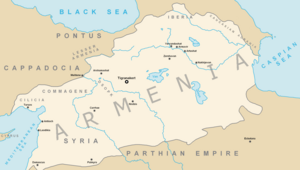Prehistoric Armenia facts for kids
The prehistory of Armenia is about the very first people who lived in the land we now call Armenia. It covers the time before written history began.
Scientists started looking for ancient remains in Armenia a long time ago. Russian experts found old burial grounds near Dilijan in 1876. Later, from 1887 to 1889, a person named Jacques de Morgan dug up 576 graves near Alaverdi and Akhatala. These discoveries helped us learn about the people who lived there long, long ago.
Contents
Stone Age Discoveries
Early Stone Age (Paleolithic)
One of the most exciting discoveries is the Nor Geghi 1 Stone Age site. It is located in the Hrazdan river valley. Thousands of tools found here are about 325,000 years old!
These tools show that new technologies appeared in different parts of the world. It suggests that new ideas didn't just spread from one place, like Africa. Instead, people in different regions developed new tools on their own.
New Stone Age (Neolithic)
The Neolithic period is also known as the New Stone Age. During this time, people started farming and living in settled villages. Sites like Aknashen and Aratashen in the Ararat plain region show evidence of this period.
The Metsamor archaeological site also has signs of settlements from the Neolithic era. It is located southwest of the Armenian village of Taronik.
Bronze Age Civilizations
The Bronze Age in Armenia began around 4000 BC. A very important early culture was the Kura-Araxes culture. It existed from about 4000 to 2200 BC.
The first signs of this culture were found on the Ararat plain. From there, it spread to Georgia by 3000 BC. It also moved west and southeast towards the Urmia basin and Lake Van.
Some scholars think the name Armenian might have appeared very early. An old inscription from 2300 BC mentions Armanî or Armânum. This name was linked to lands conquered by Naram-Sin. Today, Modern Assyrians still call Armenians Armani.
The name Hayastan is what Armenians (Hayer) call their country. This word might come from ancient Hittite texts from the Late Bronze Age. These texts mention a kingdom called Hayasa-Azzi.
Another record from 1446 BC mentions people called Ermenen. This was written by Pharaoh Thutmose III of Egypt. He said that in their land "heaven rests upon its four pillars." However, we cannot be completely sure if these old names refer to Armenia. The first definite mention of Armenia comes from the Behistun Inscription around 500 BC.
Iron Age Developments
The Iron Age followed the Bronze Age. This period brought big changes to human progress. In Armenia, the shift from bronze to iron was gradual.
Early Assyrian groups often came to Armenia to get metals. Tombs from older times only had bronze items. But in many burial sites, both bronze and iron objects were found. This shows how people slowly started using iron more and more.
Images for kids
See also
 In Spanish: Prehistoria en Armenia para niños
In Spanish: Prehistoria en Armenia para niños




